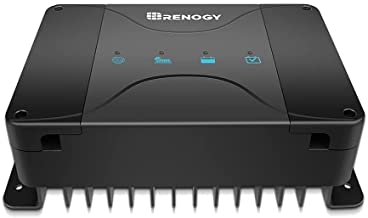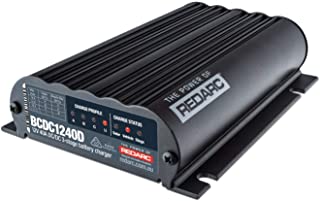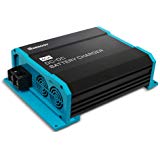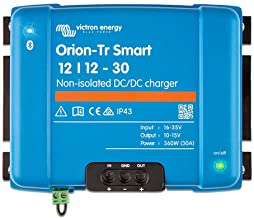User Tools
This is an old revision of the document!
Table of Contents
Battery to battery chargers
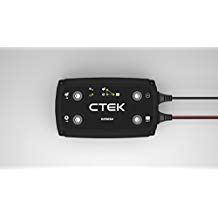 A b2b (or dc-dc) charger is a type of isolator that converts alternator voltage to specific voltage setpoints instead of just passing it through as a relay might.
A b2b (or dc-dc) charger is a type of isolator that converts alternator voltage to specific voltage setpoints instead of just passing it through as a relay might.
Because of their electronic nature they are limited to a rated amount of current1) which can protect your alternator from damage. This can be especially important with Lithium and AGM batteries that can demand huge loads from the alternator when discharged.2)
limitations
Charger throughput is generally limited to 20-30A3) since higher rates would dictate $$$ internal components, whereas plain isolators might pass as much current as the alternator, battery, and wiring could handle. This isn't as big a limitation as it might seem since lead-acid current acceptance drops substantially throughout Absorption, and lithium owners often limit charging to C/5 for maximal longevity.
Untested theory: b2b chargers might work well beside normal isolators; this is essentially the $$$ CTEK SmartPass setup described below.
In addition, even DC-DC chargers can fail to charge lead batteries fully. Lead-acid batteries require two things to get fully charged:
- a high enough Absorption voltage (Vabs) - DC-DC chargers handle this nicely.
- enough time at that voltage for the battery to stop accepting much current.4) If you aren't driving for (say) 5 hours then the charger can't charge for 5 hours to meet the battery's needs. 5) This is where a bit of solar helps with the long-duration duties.
DC-DC chargers are often triggered by the IGN circuit, but voltage sensing can be added to that circuit. Others are triggered by chassis-side voltage alone.
DC-DC chargers typically do not support self-jumpstarting, although the need for jumpstarting may be reduced with combo units (below) that maintain the starter battery from solar power.
Dual-input (alternator + solar) units make charging source decisions that are sometimes quirky. See below.
sizing
DC-DC chargers come in different ratings (10A, 40A, 60A, etc) which increase significantly in price as the rating increases. In general, the stated rating is on the output (battery charging) side. Some exceptions do exist; Sterling units are rated on the input (power taken from the alternator).6)
The DC-DC should be big enough to meet your charging targets given the amount of driving you do and the contributions of other forms of charging. It should be small enough that the alternator can provide the power continuously.
Note that bigger is not always better; different battery chemistries and capacities accept current at different rates. Buying more charging capacity than the battery wants7) is a waste of money. Buying more charging capacity than your alternator can deliver constantly can overheat/damage the alternator.
Assuming a 100Ah bank:
- Flooded lead-acid accepts a maximum of about C/5, or 20A and requires a minimum of C/10 (10A). In this case, 10-20A of charging capacity would be appropriate. Less than 10A would be insufficient for battery health and more than 20A would be wasted expense.
- AGM lead-acid accepts a max of about C/3, or 33A per 100A of battery capacity, and requires a minimum of C/5 (20A). In this case, 20-33A of charging capacity would be appropriate. Less than 20A would be insufficient for battery health and more than 33A would be wasted expense.8)
- Lithium has very low internal resistance and may be able to slurp up all the alternator has to give.9) For longevity C/5-C2.5 charging is in the sweet spot, so 20A - 40A charging would be appropriate. If you are charging by alternator alone and have limited time to do so, some BMS allow up to 1C charging (100A). The bank will not be expected to last as many cycles or stay balanced under aggressive charging but the option is there for people who need it.
isolated chargers
Isolated DC-DC chargers have negative terminals output side (battery bank) “galvanically isolated” from the input side (alternator). It is not needed for most use cases:
Generally speaking, one only needs to isolate the negatives when the installation does not share a common negative return path, such as may be the case on many fiberglass boats that don't have a chassis and may not have a common grounding bus to which all their battery banks connect. – Justin Cook10)
But note that a trailer does not always have common grounding:
Galvanically isolated is a nice thing to have, especially if you are charging house batteries in a trailer from the tow vehicle engine. The issue relates to how the house battery is grounded to chassis ground when the tow vehicle is disconnected. All in one RVs and vans don't have this issue (probably) so I would not expect them to need galvanic isolation. (emphasis added) – HaldorEE11)
examples - combo with solar charge controller
Combining the solar charge controller and DC-DC charger in one unit can have benefits in cleaner/simpler installation, starter battery maintenance from solar, and perhaps cost over separate components. The downsides are less configurabilty12), single points of failure, and limited options on solar input.
Combo units typically have much lower maximum panel input voltages (as low as 23v) than a standalone charge controller would (60v - 150v). This limits the solar configuration in a few ways:
- series panel arrangements are effectively ruled out
- higher-voltage panels (nominal 20v, 24v) are effectively ruled out
- even nominal 12v panels with high Voc may be problematic. Poly panels, with their typically-lower Vmp/Voc, may be especially useful with combo units.
CTEK D250 series
 The most common b2b charger with 'dwellers is the D250 series, all of which are 20A smart chargers with integrated MPPT:
The most common b2b charger with 'dwellers is the D250 series, all of which are 20A smart chargers with integrated MPPT:
- D250 (pre-2018, discontinued) - the original, Vabs == 14.4v, Vfloat == 13.6v.
- CTEK D250SA, a 20A solar/alt controller. Vabs selectable 14.4v and 14.7v. Vfloat 13.6v. Added support for smart alternators.
- D250SE which has 14.2 Vabs and 13.3 Vfloat for lithium settings.
House and starter batteries are combined when the starter battery holds >13.1v for 5 seconds.13) The batteries are isolated when the starter battery is “<12.8V, for 10 sec… or service battery voltage > starter battery voltage”.
Note: the CTEK D250SA14) panel voltage (Vpanel) maximum is 23v.15) There are user reports that the unit is repairable after overvoltage or polarity damage.16),17)
The MPPT charger will charge the house battery at up to 20A. CTEK specifies 50-300W of panel, though the 23v Vmax limits the unit to nominal 12v panels. Note: polycrystalline panels may be more useful here, as their Voc should be a bit lower than mono.
solar+alternator behavior
The 250-series will charge simultaneously from solar and alternator up to the 20A output limit. No details are given in the manual.
with Smartpass
The SmartPass accessory adds up to 80A-120A (see below) of alternator charging to the D250's output under certain conditions for a theoretical charging max of 100A-140A, depending on version:
- Smartpass 80 - original model. 80A + 20A = 100A.
- Smartpass 120. 120A + 20A = 140A.
- SmartPass 120S as above, but with support for smart alternators.
The Smartpass is effectively an isolator (details here), which means it can only charge the house battery at alternator voltage.
- during early Bulk stage the combined max charging will be present. Actual charging current will depend on bank acceptance, wiring resistance, alternator voltage etc.
- as house bank voltage rises the 20A DC-DC will continue pushing ~20A18). Isolator charging current tapers, as is normal for them.
- when house battery voltage > alternator voltage the Smartpass can no longer contribute. MOSFETs keep current from leaking backwards through the Smartpass back to the chassis. The 20A DC-DC continues voltage-boosted charging through Absorption 19) and eventually Float if enough time is available.
The smartpass also adds a form of self-jumpstarting.
starter battery maintenance behavior
The D250SA trickle charges the starter battery from a solar panel at intervals of 3 seconds if the service battery is fully charged.20)
Renogy
DCC series
- DCC50S 50A model with MPPT charging. MPPT input limited to 25v.21) - manual (pdf) Total output is limited to 50A from either independent source (see below). Absorption duration for lead chemistries is hardcoded at 2 hours, is typically not long enough to fully charge those chemistries.
Note: a 30A combo model is also available
solar+alternator behavior
This device's behavior regarding solar+alternator charging is widely misunderstood.
The 50A dual-input charger prefers to charge by solar if possible, up to 50A. If it cannot meet charging demands alone and the engine is running it will will charge up to 25A by solar and 25A by alternator:
charging examples
Using the above information and a theoretical scenario where we have 15A22) of solar charging available during the daytime, an alternator capable of delivering 50A, and a bank able to accept 50A of charging:
- driving at night: 50A alternator + 0A solar = 50A total charging
- parked in daytime: 0A alternator + 15A solar = 15A total charging
- driving in daytime: 25A alternator + 15A solar = 40A total charging
Behavior is the same for the 30A model (pdf) except 15A + 15A vs 25A + 25A above.
Note: some have reported better alternator charging performance with the D+ (smart alternator) wire connected, even with plain alternators. Oversizing cables from the alternator may also help. 23)
starter battery maintenance behavior
If the service battery is in float charge stage, the starting battery will be charged at the same time. The charging voltage is limited at 13.8V. The charging amperage is limited at 25A.24)
Kisae
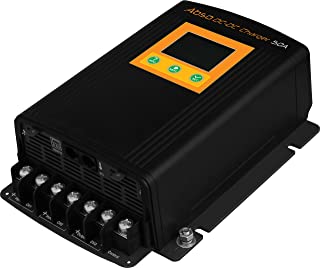 Kisae makes a DMT1230 DC-DC charger 30A charger with 50v MPPT input and 16v alternator input.25) They also make a 50A model (DMT1250), which charges up to 50A by alternator. Some sources give 50v as max input; check the current manual for your device. Both models list specifiy 500w of panel with up to 20% overpaneling (600w). The Kisae has a minimum solar input voltage of 14.5v. It can limit current output to a setpoint configured by the user, and drop to float based on trailing amps.
Kisae makes a DMT1230 DC-DC charger 30A charger with 50v MPPT input and 16v alternator input.25) They also make a 50A model (DMT1250), which charges up to 50A by alternator. Some sources give 50v as max input; check the current manual for your device. Both models list specifiy 500w of panel with up to 20% overpaneling (600w). The Kisae has a minimum solar input voltage of 14.5v. It can limit current output to a setpoint configured by the user, and drop to float based on trailing amps.
Both the 30 and 50 are limited to 30A of solar input current.26). They estimate this will be ~500w of actual input wattage27), with overpaneling allowed to 600w.
Given MPPT's DC-DC conversion we would expect >30A on the output. They do give an example of 500W practical input max with nominal 12v panels. If we use their 97% claim it would pass up to 485W. So if it charging at 13.0v we might see something like 37A. – secessus
Customer support is generally regarded as excellent.
- additional solar input information from a support email
solar+alternator behavior
By default, when the alternator input terminals detect at least 13.2v the charger will be switched to alternator charging.28) The unit can be set to prefer solar charging instead.
starter battery maintenance behavior
The Kisae does not appear to maintain the starter battery.
Redarc
Redarc “dual input” DC-DC chargers have integrated MPPT controllers. They appear to do both buck and boost conversion as solar input voltage is 9v-32v.29)
solar+alternator behavior
starter battery maintenance behavior
These units do not appear to maintain the starter battery from solar. Redarc does document how to insert a switched relay in between the starter and aux batts to self-jumpstart.
Ring Automotive
Ring makes a 30A DC-DC charger with 50v max input MPPT. (manual)
Note: the Ring appears very similar to the Kisae (above).
Votronics Triple
The Votronics Triple is DC-DC, MPPT solar, and shore power charging from 110v-230v, 45Hz-65Hz.
The naming convention is shore power amps32) / DC-DC amps / solar wattage
- VBCS 30/20/250, so 30A from shore, 20A from the alternator, or up to 250w of solar
- VBCS 45/30/350
- VBCS 60/40/430
Max solar input voltage for all models is 36Voc. Minimum panel wattage is 50w-60w depending on model.
solar+alternator behavior
Solar can be prioritized over shore power charging. The Solar Operation section of the manual suggests that alternator charging has priority over solar. The default priority appears to be:
- shore power
- alternator
- solar
starter battery maintenance behavior
The starter battery will be maintained at ≤5A by solar or mains charging. Max input voltage is 32v.
Wagan
Wagan sells 25A and 40A DC-DC chargers with MPPT inputs. The 32v max input and other specs suggest internals may be similar to Redarc units (see above).
examples - standalone
Sterling
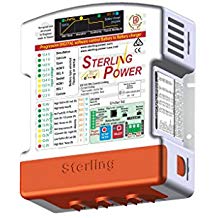 The Sterling Pro Batt Ultra series can be configured to exact setpoints. The BB1260-12 is a 30A example and costs about $50 more than the D250S above.
The Sterling Pro Batt Ultra series can be configured to exact setpoints. The BB1260-12 is a 30A example and costs about $50 more than the D250S above.
Renogy
DC1212 series
DC-DC chargers in 20A, 40A, and 60A output. Switched on by ignition circuit on the D+ port.33) DIP switches for battery type, Vabs and Vfloat. manual (pdf) teardown Note: some versions of the manual may have a typo.
These chargers appear to have a 3 hour absorption duration. This is usually insufficient for lead chemistries, but still longer than the 2 hour duration of the DCC series above. From the manual:
By default, absorption will not exceed 3 hours to prevent overcharging.
Rego series
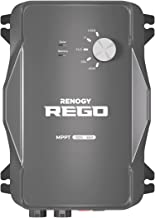 60A DC-DC with different form factor and a configurable USER profile. Important differneces from teh 1212 line above:
60A DC-DC with different form factor and a configurable USER profile. Important differneces from teh 1212 line above:
- configurable output current - 60A/50A/40A/30A/20A/10A
- voltage-sense triggering rather than D+
- 10-300min boost duration in USER mode
- 120min boost duration still hard-coded in predefined lead-chemistry modes, BUT will drop to Float if output is less than 3A (ie Absorption termination based on endAmps)
manual (pdf)
Redarc
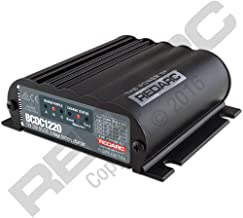 Redarc makes DC-DC chargers in 20A and 40A sizes.
Redarc makes DC-DC chargers in 20A and 40A sizes.
They have modes for “AGM, gel, calcium content, VRLA and standard lead acid batteries”.
Victron
Victron makes several DC-DC chargers, some of which are configurable by bluetooth. 12v examples:
- Orion-Tr 12|12-20 20A
See information on isolated v. non-isolated chargers above.
Be aware the physical jumpers may have a specific orientation.
Bogart
Bogart's SC-2030 can work as a DC-DC charger as well as a PWM charge controller.
Votronics
Votronics makes a range of standalone DC-DC chargers
- VCC 1212 series (12v alternator → 12v bank), in 20A, 30A, 50A, 70A, and 90A
- VCC 1224 series (12v alternator → 24v bank in 25A
- VCC 2412 series (24v alternator→ 12v bank) in 25A, and 45A
- VCC 2424 series (24v alternator→ 24v bank) in 25A, and 45A
The chargers can be activated by D+34) wire35) and disconnects <11.2v after 30 seconds.
When sensing voltage it connects at >13.3v, reduces charging at <13.0v, and disconnects at <12.9v after 30 seconds.36)
starter battery maintenance behavior
The starter battery will be maintained with ≤1A current when lead banks are >13.1v, and when lithium banks are >13.5v.37)
examples - 12v to 24v
Charging a 24v bank from 12v alternator is possible but gear selection is relatively slim.
Victron makes 12/2438) DC-DC chargers with inputs 8-17v and outputs of 20-30v.
- Orion-TR 15A, non-isolated
- Orion-TR 15A, isolated
- Orion-TR 5A, IP43, isolated
Also see the Votronics section above for their DCC 25A 1224 charger.
gotchas
DC-DC chargers are typically rated on their output power, which means they can pull more than their rating from your alternator. This could be a consideration if you are running a small alternator and relatively big DC-DC.
Example: Relatively low chassis voltage, 13.4v. Relatively high charging voltage, 14.8v.39). 50A output @ 14.8V requires 57.98A from the alternator after DC-DC boosting and losses.
Carefully observe voltage input maximums on units with built-in solar charge controllers. If you will be in freezing conditions allow headroom to account for the effects of temperature on solar cell voltage.
Voltage-sensing units40) can misbehave when an undersized starter battery charger/maintainer is attached. For this example we assume a 10A maintainer and a 20A DC-DC charger.
- starter battery voltage rises from 10A maintainer charging…
- triggering the DC-DC charger…
- which begins pulling up to 20A from the chassis
- pulling down the starter battery since the 10A maintainer cannot keep up
- starter battery voltage drops far enough the DC-DC turns off
- repeat forever
The workaround is to either charge the house battery first or to buy a big enough starter battery maintainer to support both the starter battery and DC-DC charger loads.
further reading
DC-DC charger (B2B) options and general discussion on DIY Solar Power Forum.

